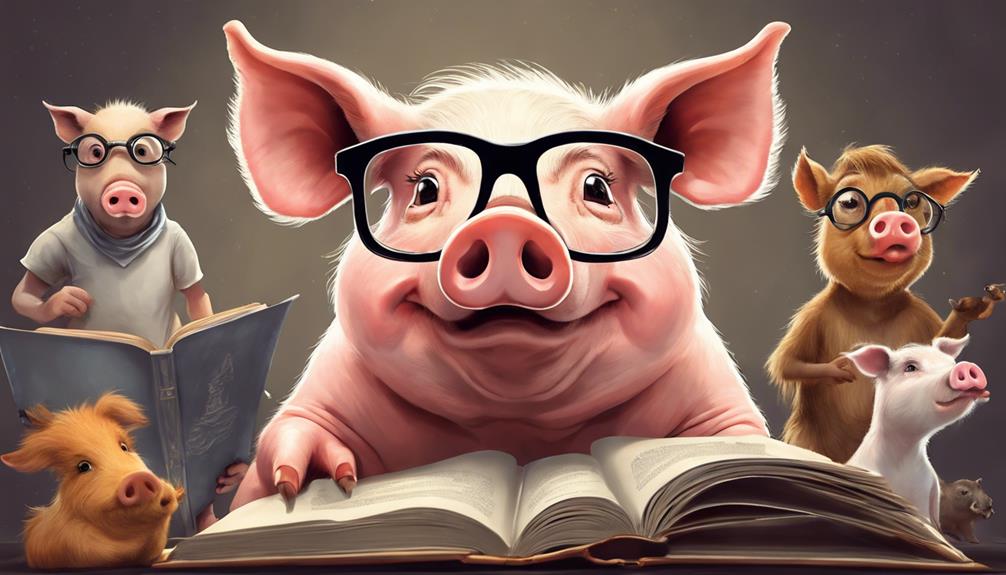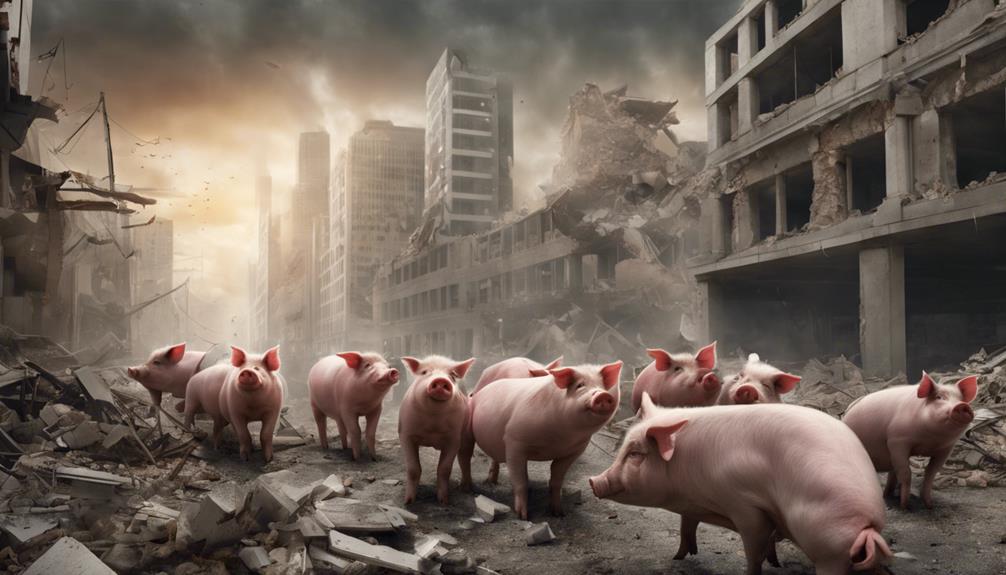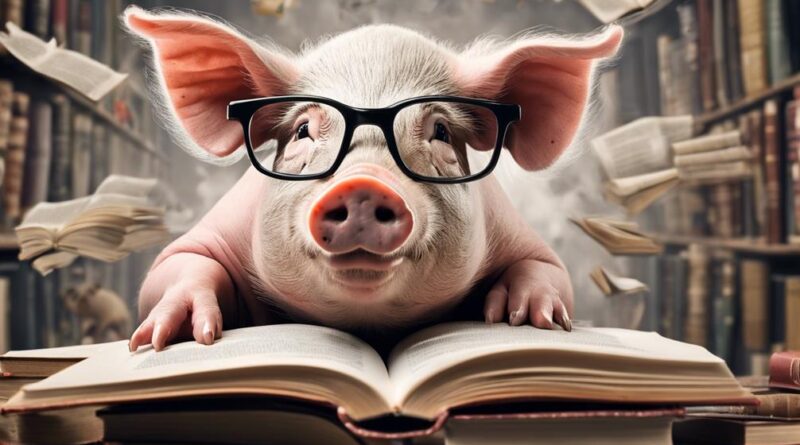Why Are Pigs Significant in Modern Literature?
In the realm of modern literature, pigs often serve as literary chameleons, seamlessly adapting to various roles and symbolisms within narratives. From embodying power dynamics to representing societal constructs, these creatures have etched themselves into the fabric of storytelling with remarkable versatility.
While their appearances may initially seem straightforward, the layers of meaning behind these porcine characters are as intricate as they are profound. Explore further to uncover the nuanced significance of pigs in contemporary literary works.
Symbolism in Animal Farm
In 'Animal Farm,' pigs symbolize the corrupt leadership and manipulation of power in society. George Orwell's novel serves as a political allegory, with the pigs representing different figures in society. Through their portrayal as intelligent and cunning animals, the pigs symbolize the ruling class and their abuse of power. The character of Napoleon, for instance, embodies the rise of authoritarianism and dictatorship. By using pigs as the primary animal representation in the story, Orwell offers a poignant societal critique on power dynamics and the potential for corruption within leadership structures.
The allegorical nature of the pigs in 'Animal Farm' allows readers to draw parallels to real-world events and historical figures. Orwell's choice to depict the pigs as the dominant group on the farm highlights how power can corrupt individuals and lead to oppression. The pigs' gradual transformation from revolutionary leaders to oppressive tyrants mirrors the ways in which those in power can betray the ideals they once espoused.
Through this symbolic representation, Orwell effectively conveys the dangers of unchecked authority and the manipulation of power for personal gain. The pigs in 'Animal Farm' stand as a stark reminder of the complexities of leadership and the need for vigilance against abuse of power.
Pig as a Metaphor
Symbolizing greed and gluttony, the pig serves as a metaphor for excess and indulgence in various literary works. In modern literature, authors frequently use pigs as a symbolic representation of deeper meanings, weaving hidden messages into their narratives. Here are three ways in which the pig is utilized as a metaphor:
- The insatiable appetite: Pigs are often depicted as creatures with voracious appetites, constantly consuming everything in their path. This portrayal symbolizes the human tendency towards excess and greed, where characters embodying pig-like qualities indulge in desires without restraint, leading to their downfall.
- The weight of indulgence: Through the image of a pig wallowing in mud or surrounded by food, authors create a vivid representation of indulgence. This excessiveness serves as a metaphor for the burdens of materialism and hedonism, highlighting the negative consequences of prioritizing physical pleasures over spiritual or moral values.
- The mask of civility: Pigs are intelligent animals that can display behaviors resembling humans. In literature, this intelligence is often twisted to reflect cunning or manipulative qualities. By portraying characters as pigs in suits or with human-like traits, authors convey the hidden meanings of deceit and corruption lurking beneath a façade of sophistication.
Pig Characters in Novels
Pigs frequently populate the pages of novels, embodying a range of characteristics and serving as pivotal figures in the narrative. Authors often use pig personalities to add depth and complexity to their stories. For example, a pig character might be portrayed as stubborn and headstrong, mirroring the obstinacy of a key human character. In contrast, another pig could exhibit intelligence and wit, providing comic relief or serving as a wise mentor to the protagonist.
In terms of pig relationships, these characters often form unique bonds with other characters in the novel. A pig's loyalty and unwavering support can create a strong emotional connection with the readers. In some cases, pig relationships symbolize themes of friendship, trust, or betrayal within the larger narrative. The interactions between pig characters and their human counterparts can shed light on the complexities of human nature, showcasing aspects of love, compassion, or even cruelty.
Through their diverse personalities and relationships, pig characters in novels play vital roles in shaping the storyline and conveying deeper messages. Whether they serve as symbols of innocence, greed, or companionship, these literary pigs leave a lasting impact on readers, inviting them to reflect on the intricate dynamics of the human experience.
Cultural Representations of Pigs
Cultural representations of pigs span various societies and artistic mediums, offering insights into the diverse symbolism and perceptions associated with these animals.
- Pig Folklore: Across different cultures, pigs have been depicted in folklore and myths with varying meanings. In some traditions, pigs symbolize wealth and abundance, while in others, they're seen as symbols of fertility and good fortune. The multifaceted nature of pig folklore highlights the complexity of human perceptions towards these creatures.
- Pig in Art: Artists throughout history have utilized pigs as subjects in their works, showcasing different aspects of human-animal relationships. From classical paintings to modern sculptures, pigs have been portrayed in art to evoke emotions, provoke thoughts, and challenge societal norms. The representation of pigs in art often serves as a reflection of cultural attitudes and values towards nature and the animal kingdom.
- Cultural Symbolism: Pigs have also been used symbolically in cultural contexts to represent various concepts such as greed, gluttony, innocence, or intelligence. These symbolic representations in literature, paintings, and other art forms provide a lens through which societal beliefs and values can be analyzed and understood. The diverse cultural representations of pigs offer a rich tapestry of meanings that continue to shape our understanding of these animals in modern society.
Pig Intelligence in Stories

Exploring the theme of cognitive abilities in narrative portrayals, pigs in stories often exhibit surprising levels of intellect and problem-solving skills, challenging traditional stereotypes associated with these animals. In various literary works, pigs are depicted as having remarkable cognitive abilities, showcasing their capacity to learn, adapt, and strategize. These portrayals highlight the complexity of pig intelligence, going beyond simplistic perceptions.
Pigs in stories are also frequently shown to experience a range of emotions, adding depth to their characters. Authors use this emotional aspect to create more relatable and engaging narratives, where pigs display empathy, joy, sorrow, and even cunning. By attributing such rich emotional lives to pigs, writers humanize these animals and invite readers to reconsider their preconceived notions about them.
Moreover, the social behavior of pigs is often a key element in storytelling. Their interactions with other characters, both human and animal, serve to illustrate intricate relationships and dynamics. Pigs are shown forming bonds, expressing loyalty, and engaging in complex social structures, shedding light on their sophisticated communication skills and social awareness.
In essence, the portrayal of pig intelligence in literature transcends mere animal characterization, offering readers a fresh perspective on these creatures' cognitive abilities, emotions, social behavior, and communication skills. By delving into the depths of pig intellect, authors challenge stereotypes and open up new avenues for exploration in storytelling.
Pig as a Source of Conflict
In narratives, the pig's presence often catalyzes conflicts, driving the plot forward with its symbolic weight and inherent contradictions. Pigs can be portrayed as antagonists, stirring up trouble and creating tension within the story. Their symbolic significance adds layers of complexity to the conflicts they generate, making them more than just ordinary farm animals.
Here's how pigs function as a source of conflict:
- Power Struggles: Pigs are often used to symbolize authority and control. When a pig assumes a position of power within a story, it can lead to power struggles among characters vying for dominance. This struggle for control can set the stage for intense conflicts and moral dilemmas.
- Betrayal and Deception: Due to their dual nature as both intelligent creatures and sources of sustenance, pigs can represent betrayal and deception. Characters may deceive others or be deceived themselves, mirroring the contradictory nature of pigs. This theme of betrayal adds a layer of tension to the narrative, driving the conflict forward.
- Social Hierarchies: Pigs are sometimes used to symbolize social hierarchies and class distinctions. Their presence can highlight disparities in wealth, status, and privilege, leading to conflicts rooted in social injustices and inequality. These disparities can ignite tensions between characters, exposing underlying societal tensions and power dynamics.
Pigs in Dystopian Settings

Pigs play a crucial role in dystopian settings, embodying themes of control and manipulation within oppressive societies. In these bleak worlds, pigs symbolize the struggle for power and the complexities of governance. One common theme is government control, where pigs are used as tools to maintain authority and dominance over the population. The pigs' actions often represent the manipulation and coercion employed by those in power to subdue dissent and enforce obedience.
In some narratives, pigs lead rebellions against oppressive regimes, symbolizing resistance and the fight for freedom. This pig rebellion against unjust governance reflects the desire for change and the quest for justice within these dystopian societies. The pigs become catalysts for societal upheaval, challenging the status quo and inspiring others to question the established order.
Within pig dystopias, societal collapse is a central theme, illustrating the consequences of unchecked power and societal decay. Pigs are often at the center of this collapse, either as agents of destruction or as victims of their own ambition. Their presence highlights the fragility of society and the dangers of unchecked authority. Through their portrayal in these dystopian settings, pigs serve as powerful symbols of the darker aspects of human nature and the potential for both oppression and resistance in the face of adversity.
Evolution of Pig Portrayals
Throughout the history of literature, the portrayal of pigs has undergone a significant evolution, reflecting changing societal perceptions and values. From being seen as simple farm animals to embodying complex symbolism, pigs have played diverse roles in storytelling. Here's how their evolution in literature can be understood:
- Innocence to Corruption:
Pigs were initially depicted as innocent creatures in children's stories, symbolizing purity and simplicity. However, over time, this portrayal evolved to showcase pigs as symbols of corruption and greed. This shift highlights society's changing views on morality and ethics.
- Intellect and Manipulation:
In some narratives, pigs have been portrayed as intelligent and manipulative beings, challenging traditional ideas of superiority among species. This evolution in pig portrayals reflects a reevaluation of human intellect and power dynamics.
- Revolution and Rebellion:
More recently, pigs have been used to symbolize revolution and rebellion against oppressive systems. This evolution in symbolism illustrates a growing desire for change and resistance against injustice in society.
As literature continues to evolve, so do the roles and representations of pigs. The evolution of pig portrayals mirrors the shifts in societal values, making them a versatile and powerful symbol in modern storytelling.
Frequently Asked Questions
Are There Any Specific Religious or Spiritual Connotations Associated With Pigs in Modern Literature?
In modern literature, pigs carry spiritual symbolism and cultural significance. They often represent various themes such as greed, gluttony, or uncleanliness. Pig imagery can symbolize the darker sides of human nature or societal issues.
Through their portrayal, authors shed light on complex human behaviors and societal norms. Pigs in literature serve as powerful metaphors, prompting readers to reflect on deeper spiritual and cultural connotations.
How Do Pigs in Literature Compare to Other Animals, Such as Dogs or Cats, in Terms of Their Significance and Portrayal?
When comparing pigs to other animals like dogs or cats in literature, think about their roles. Pigs often represent more than just pets; they carry cultural symbolism and deeper meanings.
Pigs can symbolize greed or intelligence, unlike dogs or cats, which might symbolize loyalty or independence. Their significance in stories varies, showing a unique perspective in comparative analysis of animal portrayals in literature.
Do Pigs in Modern Literature Always Represent Negative Traits or Are There Examples of Positive Pig Characters?
In modern literature, positive portrayals of pigs do exist alongside negative ones. These characters can symbolize redemption, hope, and innocence amidst themes of corruption and greed.
How Have Authors Used Pigs in Literature to Comment on Societal Issues or Political Themes?
Authors have cleverly utilized pigs in literature to comment on societal issues and political themes. By portraying pigs as symbols of power dynamics, they provide a social critique that reflects real-world dynamics.
Through these representations, authors can delve into complex themes and make poignant statements about society and politics. Pigs serve as a versatile tool for conveying messages about authority, corruption, and the human condition in a compelling and thought-provoking manner.
Are There Any Instances Where Pigs in Literature Have Been Portrayed as Symbols of Hope or Redemption, Rather Than Corruption or Greed?
In literature, pigs have been depicted as symbols of hope and redemption. These portrayals offer a refreshing perspective, showcasing the potential for positive change and renewal.
Through their hopeful symbolism, pigs serve as beacons of light in narratives, inspiring characters and readers alike to believe in the possibility of transformation and second chances.
Such representations enrich stories with themes of redemption, emphasizing the inherent goodness that can be found even in unexpected places.
Conclusion
In modern literature, pigs play a significant role as symbols, metaphors, and characters that add depth and complexity to stories. From Animal Farm's political allegory to the portrayal of intelligent and conflicted pigs in dystopian settings, these animals offer unique perspectives on society, power dynamics, and human nature.
As their representations evolve, pigs continue to captivate readers with their multifaceted roles in literature. So next time you encounter a pig in a story, remember the layers of meaning they bring to the narrative.
